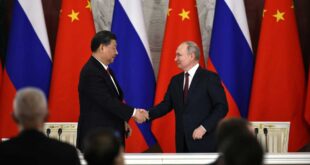There is no doubt that the return of Huawei’s CFO Meng Wanzhou to Beijing marks a historic event for the entire country that made every Chinese person incredibly proud, especially bearing in mind its timing, as the National Day celebrations took place on October 1.
“Where there is a five-star red flag, there is a beacon of faith. If faith has a color, it must be China red,” Ms. Meng said to the cheering crowd at Shenzhen airport after returning home from Canada. She also added that “All the frustration and difficulties, gratitude and emotion, steadfastness and responsibility will transform into momentum for moving us forward, into courage for our all-out fight.”
Regardless of how encouraging the Chinese tech giant heiress’s words may sound, the fact remains that the company remains a target of U.S. prosecution and sanctions—something that is not about to change anytime soon.
When the Sanctions Bite
It was former U.S. President Donald Trump who in May 2019 signed an order that allowed the then-Commerce Secretary Wilbur Ross to halt any transactions concerning information or communications technology “posing an unacceptable risk” to the country’s national security. As a result, the same month, Huawei and its non-U.S. affiliates were added to the Bureau of Industry and Security Entity List, which meant that any American companies wishing to sell or transfer technology to the company would have to obtain a licence issued by the BIS.
In May 2020, the U.S. Department of Commerce decided to expand the FPDP Rule by restricting the Chinese tech giant from acquiring foreign-made semiconductors produced or developed from certain U.S. technology or software and went even further in August the same year by issuing the Final Rule that prohibits the re-export, export from abroad or transfer (in-country) of (i) certain “foreign-produced items” controlled under the amended footnote 1 to the Entity List (“New Footnote 1”) when there is (ii) “knowledge” of certain circumstances, the scope of which were also expanded.
Moreover, the decision also removed the Temporary General License (“TGL”) previously authorizing certain transactions with Huawei and added thirty-eight additional affiliates of the Chinese company to the Entity List.
In these particular circumstances, despite the initial predictions made by Bloomberg early in 2020 that Trump’s decision to blacklist Huawei fails to stop its growth, the current reality seems to be slightly changing for once—and briefly—the world’s largest smartphone vendor.
The impact of the U.S. sanctions has already resulted in a drop in sales in the smartphone business by more than 47% in the first half of 2021, and the total revenue fell by almost 30% if we compare it with the same period in 2020. As is estimated by rotating Chairman Eric Xu, the company’s revenue concerning its smartphone sales will drop by at least $30-40 billion this year.
For the record, Huawei’s smartphone sales accounted for $50 billion in revenue last year. The company has generated $49.57 billion in revenue in total so far, which is said to be the most significant drop in its history.
In Search of Alternative Income Streams
Despite finding itself in dire straits, the company is in constant search for new sources of income with a recent decision to charge patent royalties from other smartphone makers for the use of its 5G technologies, with a “per unit royalty cap” at $2.50 for every multimode mobile device capable of connections to 5G and previous generations of mobile networks. Huawei’s price is lower than the one charged by Nokia ($3.58 per device) and Ericsson ($2.50-$5 per device).
Notably, according to data from the intellectual property research organization GreyB, Huawei has 3,007 declared 5G patent families and over 130,000 5G active patents worldwide, making the Chinese company the largest patent holder globally.
Jason Ding, who is head of Huawei’s intellectual property rights department, informed early this year that the company would collect about $1.2-$1.3 billion in revenue from patent licensing between 2019 and 2021. But royalties will not be the only revenue source for the company.
Investing in the Future: Cloud Services and Smart Cars
Apart from digitizing native companies in sectors like coal mining and port operations that increased its revenue by 23% last year and 18% in the first part of 2021, Huawei looks far into the future, slowly steering away from its dependency on foreign chip supplies by setting its sight on cloud services and software for smart cars.
Seizing an opportunity to improve the currently not-so-perfect cloud service environment, the Chinese tech giant is swiftly moving to have its share in the sector by creating new cloud services targeting companies and government departments. For this purpose, it plans to inject $100 million over three years’ period into SMEs to expand on Huawei Cloud.
As of today, Huawei’s cloud business is said to grow by 116% in the first quarter of 2021, with a 20% share of a $6 billion market in China, as Canalys reports.
“Huawei Cloud’s results have been boosted by Internet customers and government projects, as well as key wins in the automotive sector. It is a growing part of Huawei’s overall business,” said a chief analyst at the company, Matthew Ball. He also added that although 90% of this business is based in China, Huawei Cloud has a more substantial footprint in Latin America and Europe, the Middle East and Africa as compared with Alibaba Cloud and Tencent Cloud.
Another area where Huawei is trying its luck is electric and autonomous vehicles, where the company is planning to invest $1 billion alone this year. Although the company has repeatedly made it clear that it is unwilling to build cars, Huawei wants to “help the car connect” and “make it more intelligent,” as its official noted.
While during the 2021 Shanghai Auto Show, Huawei and Arcfox Polar Fox released a brand new Polar Fox Alpha S Huawei Hi and China’s GAC revealed a plan to roll out a car with the Chinese tech company after 2024, Huawei is already selling the Cyrus SF5, a smart Chinese car from Chongqing Xiaokang, equipped with Huawei DriveONE electric drive system, from its experience store for the first time in the company’s history. What’s more, the car is also on sale online.
R&D and International Talent as Crucial Ingredients to Become Tech Pioneer
There is a visible emphasis put on investing in high-quality research and development to innovate both in Huawei and China as a whole.
According to the company’s data, the Chinese technology giant invested $19.3 billion in R&D in 2019, which accounted for 13.9% of its total business revenue and $22 billion last year, which was around 16% of its revenue. Interestingly, if Huawei was treated as a provincial administrative region, its R&D expenditure would rank seventh nationwide.
As reported by China’s National Bureau of Statistics, the total R&D spending in China last year was 2.44 trillion yuan, up 10.6% year-on-year growth, and 2.21 trillion yuan in 2019, with 12.3% year-on-year growth.
As far as activities are concerned, the most were spent on experimental development in 2020 (2.02 trillion yuan, which is 82.7% of total spending), applied research (275.72 billion yuan, which gives 11.3%) and basic research (146.7 billion yuan, accounting for 6%). While the most money was spent by enterprises (1.87 trillion yuan, which gives up 10.4% year-on-year), governmental research institutions spent 340.88 billion yuan (up 10.6% year-on-year), and universities and colleges spent 188.25 billion yuan (up 4.8% year-on-year).
As far as industries go, it is also worth mentioning that high-tech manufacturing spending accounted for 464.91 billion yuan, with equipment manufacturing standing at 913.03 billion yuan. The state science and tech spending accounted for 1.01 trillion yuan, which is 0.06 trillion yuan less than in 2019.
As Huawei raises the budget for overseas R&D, the company also plans to invest human resources by attracting the brightest foreign minds into its business, which is in some way a by-product of the Trump-era visa limitations imposed on Chinese students.
So far, concentrating on bringing Chinese talent educated abroad, Huawei is determined to broader its talent pool by “tall noses,” as the mainland Chinese sometimes refer to people of non-Chinese origin.
“Now we need to focus on bringing in talent with ‘tall noses’ and allocate a bigger budget for our overseas research centres,” said the company’s founder Ren Zhengfei in a speech made in August. “We need to turn Huawei’s research center in North America into a talent recruitment hub,” Ren added.
While Huawei wants to scout for those who have experience working in the U.S. and Europe, it wants to meet the salary standards comparable to the U.S. market to make their offer attractive enough.
What seems to be extraordinary and crucial by looking at China through Huawei lens is that it is, to the detriment of its critics, indeed opening to the outside world by aiming at replenishing all facets of its business.
“We need to further liberate our thoughts and open our arms to welcome the best talent in the world,” to quote Ren, in an attempt to help the company become more assimilated in overseas markets as a global enterprise “in three to five years”.
The Chinese tech giant aims to attract international talent to its new 1.6 million square meter research campus in Qingpu, Shanghai, which will house 30,000 to 40,000 research staff primarily concerned with developing handset and IoT chips. The Google-like campus is said to be completed in 2023.
The best sign of Huawei’s slow embrace of the “start-up” mentality, as the company’s head of research and development in the UK, Henk Koopmans, put it, is the acquiring of the Center for Integrated Photonics based in Ipswich (UK) in 2012, which has recently developed a laser on a chip that can direct light into a fibre-optic cable.
This breakthrough discovery, in creating an alternative to the mainstream silicon-based semiconductors, provides Huawei with its product based on Indium Phosphide technology to create a situation where the company no longer needs to rely on the U.S. know-how.
As for high-profile foreign recruitments, Huawei has recently managed to hire a renowned French mathematician Laurent Lafforgue, a winner of the 2002 Fields Medal, dubbed as the Nobel Prize of mathematics, who will work at the company’s research center in Paris, and appointed the former head of BBC news programmes Gavin Allen as its “executive editor in chief” to improve its messaging strategy in the West.
According to Huawei’s annual report published in 2020, the Shenzhen-based company had 197,000 employees worldwide, including employees from 162 different countries and regions. Moreover, it increased its headcount by 3,000 people between the end of 2019 and 2020, with 53.4% of its employees in the R&D sector.
The main objective of the developments mentioned above is to “lead the world” in both 5G and 6G to dominate global standards of the future.
“We will not only lead the world in 5G, more importantly, we will aim to lead the world in wider domains,” said Huawei’s Ren Zhengfei in August. “We research 6G as a precaution, to seize the patent front, to make sure that when 6G one day really comes into use, we will not depend on others,” Ren added.
Discussing the potential uses of 6G technology, Huawei’s CEO told his employees that it “might be able to detect and sense” beyond higher data transmission capabilities in the current technologies, with a potential to be utilized in healthcare and surveillance.
Does the U.S. Strategy Towards Huawei Work?
As we can see, the Chinese tech giant has not only proved to be resilient through the years of being threatened by the harmful U.S. sanctions, but it also has made significant steps to become independent and, therefore, entirely out of Washington’s punishment reach.
Although under the intense pressure from the Republicans the U.S. Commerce Secretary Gina Raimondo promised that the Biden administration will take further steps against Huawei if need be, it seems that there is nothing much that the U.S. can do to stop the Chinese company from moving ahead without any U.S. permission to develop in the sectors of the future, while still making a crucial contribution to the existing ones.
At the same time, continuing with the Trump-era policies aimed at Huawei is not only hurting American companies but, according to a report from the National Foundation for American Policy published in August 2021, it also “might deal a significant blow to innovation and scientific research” in the country.
“Restricting Huawei from doing business in the U.S. will not make the U.S. more secure or stronger; instead, this will only serve to limit the U.S. to inferior yet more expensive alternatives, leaving the U.S. lagging behind in 5G deployment, and eventually harming the interests of U.S. companies and consumers,” Huawei said in, what now appears to be, prophetic statement to CNBC in 2019.
On that note, perhaps instead of making meaningless promises to the Republicans that the Biden administration “wouldn’t be soft” on the Chinese tech giant, Raimondo would make the U.S. better off by engaging with Huawei, or at least rethinking the current policies, which visibly are not bringing the desired results, yet effectively working to undermine the U.S. national interest in the long run.
 Geostrategic Media Political Commentary, Analysis, Security, Defense
Geostrategic Media Political Commentary, Analysis, Security, Defense





